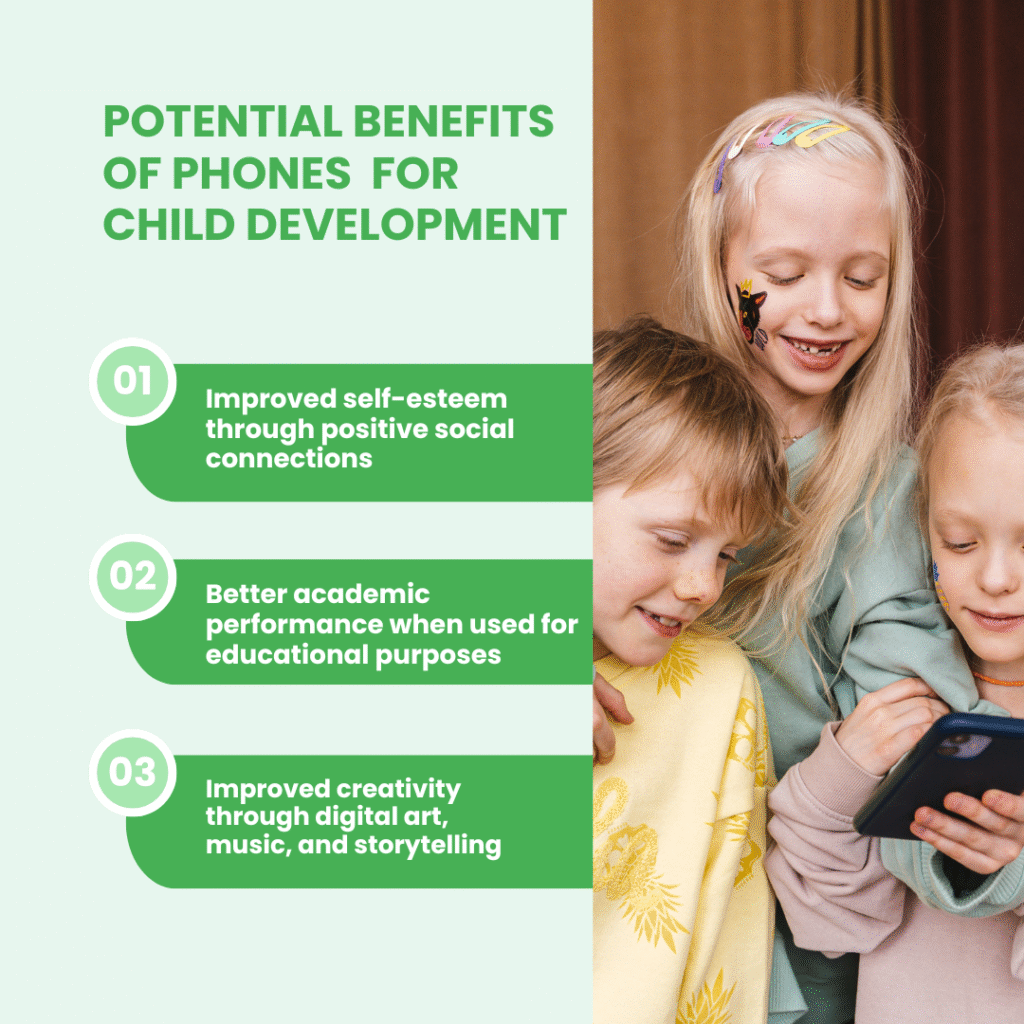Parents today face a challenging dilemma: smartphones connect our children to educational resources, friends, and family, but they also expose kids to potential risks that weren’t part of our own childhoods. If you’re wondering whether to give your child a phone—or how to manage the one they already have—you’re not alone.
Recent research paints a complex picture. A comprehensive study found that 30-50% of young users develop problematic usage patterns that can affect mental health. Yet other studies show benefits when devices are used appropriately with proper guidance.
Let’s explore what science actually tells us about kids and smartphones, and look at practical solutions that can help your family find the right balance.
Mental Health and Addictive Patterns
The relationship between smartphones and mental health isn’t as simple as “screen time is bad.” What matters most is how phones are used.
A long-term study published in JAMA Psychiatry found that compulsive phone use—not just total time spent—was linked to increased anxiety, depression, and in some cases, suicidal thoughts among adolescents. Kids who felt unable to put their phones down showed the most significant negative effects.
Sapien Labs’ research with early teens revealed concerning patterns where excessive social media use correlated with increased aggression and, in some cases, hallucinations. However, Dr. Jean Twenge, a psychology professor who studies generational differences, notes an important distinction: “It’s not just about how much time kids spend on phones, but whether that use becomes compulsive and replaces essential activities like sleep, exercise, and face-to-face interaction.”
Children who use phones primarily for learning, creativity, or connecting with friends and family typically show fewer negative effects than those whose use centers on passive scrolling or social comparison.
Cognitive, Language, and Brain Development
For younger children, the impact of smartphones on development raises particular concerns.
Researchers at Boston University found that when parents use phones during interactions with infants, their verbal input drops by 16-26%. This reduction matters because babies develop language through these exchanges.
Brain imaging studies have detected reduced white matter—the connective tissue that helps brain regions communicate—in preschoolers with high screen time. The American Academy of Pediatrics suggests this may affect language acquisition and executive function.
“Children learn through interaction,” explains developmental psychologist Dr. Sarah Coyne. “When a screen replaces conversation, we see impacts on attention span and vocabulary development.”
But it’s not all negative. Interactive video calls with grandparents or educational apps used alongside parents can support learning. A University of Wisconsin study found that toddlers who engaged with educational content alongside parents showed vocabulary improvements compared to those who watched passively.
Sleep and Physical Health
One of the clearest impacts of smartphones appears in children’s sleep patterns.
Multiple studies confirm that using devices before bedtime disrupts melatonin production—the hormone that regulates sleep. Children who use phones within an hour of bedtime typically take longer to fall asleep and experience poorer sleep quality.
Dr. Lisa Meltzer, a pediatric sleep specialist, explains: “The blue light from screens tells the brain it’s still daytime, making it harder to wind down. Plus, the content itself can be stimulating rather than calming.”
Beyond sleep, physical concerns include:
- Increased sedentary behavior, which correlates with weight gain
- Eye strain and myopia progression from close-up screen viewing
- Neck and back issues from poor posture during device use
Social and Family Dynamics
Smartphones affect not just individual children but entire family systems.
Research on parental “phubbing” (phone snubbing) shows that when parents frequently check phones during family time, children are more likely to develop their own problematic phone habits. One study found that parents check their phones an average of 70 times daily, often during conversations with their children.
“Technoference”—technology-based interruptions in parent-child interactions—has been linked to:
- Lower cognitive development scores in toddlers
- Reduced emotional attachment between parents and children
- More behavioral issues, particularly in younger children
Schools are also grappling with these challenges. Some have implemented total bans, while others focus on teaching responsible use. Research suggests that balanced policies that teach digital citizenship may be more effective than outright prohibition.
A Balanced View: Potential Benefits

Despite concerns, smartphones can offer significant benefits when used thoughtfully.
A University of South Florida study found that moderate smartphone use was associated with positive outcomes in some teens, including:
- Improved self-esteem through positive social connections
- Better academic performance when used for educational purposes
- Enhanced creativity through digital art, music, and storytelling
The Poynter Institute’s research challenges the notion that phones automatically reduce in-person socializing. Their findings suggest many teens use phones to coordinate face-to-face gatherings and maintain friendships during periods when in-person meetings aren’t possible.
The American Academy of Pediatrics has updated its stance in recent years, acknowledging that supervised, high-quality screen use can be appropriate for children 18 months and older. They emphasize that content quality, parental involvement, and individual child temperament all influence outcomes.
Guidelines and Age-Appropriate Use
Based on current research, experts suggest these general guidelines:
For babies and toddlers (under 2):
- Minimal to no screen time, except for video chats with family
- Never use screens as pacifiers or babysitters
For preschoolers (2-5):
- Limit to 1 hour per day of high-quality content
- Always watch together and discuss what you’re seeing
- Prioritize educational content and creative applications
For elementary school (6-10):
- Begin with shared devices rather than personal phones
- Establish tech-free zones (bedrooms, dinner table)
- Focus on teaching digital literacy and safety
For middle school (11-13):
- Consider a basic phone with limited features
- Set clear boundaries around usage times and places
- Use parental controls while teaching responsible habits
For teens (14+):
- Gradually increase independence as responsibility is demonstrated
- Maintain open conversations about online experiences
- Model healthy tech habits yourself
Dr. Michael Rich, director of the Center on Media and Child Health, emphasizes: “It’s less about rigid time limits and more about creating a healthy pattern. Does phone use enhance or detract from sleep, physical activity, schoolwork, and family connections?”
Practical Tools: MMGuardian as a Solution
For parents seeking a middle ground between no phone and unrestricted access, tools like MMGuardian kids phone offer practical solutions.
MMGuardian works with phones like the Samsung to create a safer experience through features such as:
AI-powered safety monitoring: The system can detect concerning images or messages related to bullying, inappropriate content, or potential predators, alerting parents to potential issues.
Customizable web filtering: Parents can block inappropriate websites while allowing educational content.
Screen time scheduling: Set automatic times when apps are unavailable, such as during school hours or after bedtime.
Message and social media monitoring: Review texts and social media activity to spot potential problems.
Location tracking: Know where your child is without having to call or text them constantly.
Parents appreciate that these controls can be adjusted as children mature, allowing for a gradual transition to digital independence. As one parent shared, “We started with tight restrictions when our daughter was 11, but by 14, we were able to loosen many controls because she’d developed good habits.”
The approach isn’t perfect—it requires a subscription, and involves privacy trade-offs that families should discuss openly. But many parents find that such tools provide peace of mind while teaching children about digital boundaries.
Expert and Institutional Recommendations
Leading organizations and researchers increasingly advocate for balanced approaches rather than fear-based restrictions.
The American Psychological Association recommends that schools focus on teaching digital literacy rather than implementing blanket bans. Their research suggests that helping children understand how to evaluate online information and manage their digital footprint produces better long-term outcomes than prohibition.
Dr. Sonia Livingstone, who studies children’s digital media use, explains: “The goal isn’t to keep children off devices entirely—that’s neither realistic nor beneficial. Instead, we should help them develop the skills to use technology wisely and safely.”
Policy experts suggest:
- Age-appropriate education about digital citizenship starting in elementary school
- Parent education programs that focus on communication rather than surveillance
- School policies that teach responsible use rather than total prohibition
- Regular family discussions about online experiences and challenges
Finding Your Family's Balance
The research is clear: smartphones are tools that can either help or harm children depending on how they’re used. The key factors that determine outcomes include:
- Content quality: Educational and creative content generally produces better outcomes than passive entertainment.
- Usage patterns: Compulsive use that displaces sleep, physical activity, or face-to-face interaction raises red flags.
- Parental involvement: Children whose parents actively discuss, monitor, and participate in their digital lives fare better.
- Individual differences: Some children are more vulnerable to problematic use based on temperament and existing mental health factors.
For most families, a thoughtful approach includes:
- Clear boundaries around when and where phones can be used
- Regular phone-free family time
- Open conversations about online experiences
- Gradual introduction of independence as children demonstrate responsibility
- Consideration of tools like MMGuardian that provide safety guardrails
Remember that your own phone habits set a powerful example. Children who see parents setting healthy boundaries with their own devices are more likely to develop similar habits.
By staying informed about the research while remaining attuned to your individual child’s needs, you can help them develop a healthy relationship with technology that will serve them well throughout life.






